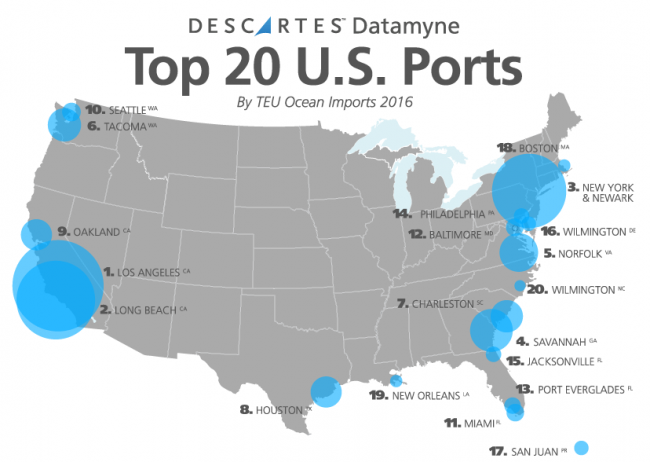New Report - The Top 20 U.S. Ports: Five-Year Trend and 2017 Outlook
Keeping a pulse on port volume trends is critical for business to gauge changing demand and to evaluate where goods should cross borders. Since ports are often a focus point of micro and macroeconomic changes, fluctuations in volume and commodities are a key indicator of industry developments.
Working with Port Technology International (PTI), the Descartes Datamyne™ Annual U.S. Port Report analyzes the top 20 U.S. ocean ports ranked by import TEUs. Our report profiles each location, covering year-over-year volume and market share trends as well as top importing companies, carriers and trading partner countries. Findings reveal key products imported through each port by Harmonized System (HS) code as well as Bill of Landing (BOL) shipment counts and values.
Click here to register to download a free PDF copy of the Descartes Datamyne Top 20 U.S. Ports Report.
In 2016, 20 ports handled 97 percent of U.S. ocean-going import volumes as measured in 20-foot equivalent units (TEUs), the standard measure for containerized cargo. In the last five years, many of these ports realized a 30 percent increase in import volume, compared with growth in U.S. imports overall, which have risen 18.6 percent since 2012.
With fluctuating labor trends, larger ocean vessels and ever-changing logistics technology, the top U.S. ports have had to adapt to stay competitive and meet changing volume demands year over year.
The Panama Canal expansion has been a prime driver of infrastructure mega-investment. To prep for larger “post-Panamax” vessels calling on their docks, East Coast ports have launched billions of dollars’ worth of development projects. The $4.3 billion capital plan of the Port Authority of New York and New Jersey includes the addition of 64 feet of air draft to the Bayonne Bridge to open access to its Port Newark-Elizabeth terminal to Post-Panamax ships.
In 2015, the port of Miami completed an expansion of its Biscayne Bay and the Port of Miami Tunnel Project. By 2020, the Port of Savannah will have dredged the Savannah River to 47 feet at mean low water. With construction starting this year, the Port of Charleston also expects to deepen its harbor to 52 feet.
Select East Coast ports have captured import market share in the last five years. In 2012, the Port of New York/Newark accounted for 9.6 percent of U.S. import TEUs. In 2016, that share grew to 15.1 percent as the port increased its import volumes 86.8 percent over five years, from 1.69 TEUs annually in 2012 to 3.16 million in 2017.
Similarly, the Port of Savannah held a 6.2 percent stake of U.S. imports in 2012; in 2016, the port’s share neared 8 percent, based on an increase of nearly 600,000 TEUs for a total of 1.67 million in 2016.
West Coast port volumes are shifting as well. For example, the Port of Los Angeles is still ranked number one in import volume, with 4.5 million TEUs imported in 2016, up 9.5 percent from 2015. However, the port’s 23.2 percent of U.S. imports in 2012 receded to 21.6 percent in 2016.
Top 10 U.S. Ports’ 5-Year Trends in Import TEU Volume and Market Share
So far in 2017, import volume at the Port of Los Angeles has grown 5.2 percent compared with the same period in 2016. The Port of Savannah has seen continuous month-over-month growth vs. January-April 2016, with imports up 10.3 percent over the first four months of 2017. Notably, 18 of the top 20 U.S. ports increased in TEU import volume this April vs. April of last year.
With a comprehensive database of accurate, up-to-date import-export information, Descartes Datamyne delivers actionable intelligence for market research, sales insight, supply chain management, enhanced security and competitive strategy. The solution is powered by the world’s largest searchable trade database, covering the global commerce of 230 markets across 5 continents.
Manufacturers, shippers wholesalers, transport and logistics service providers, management consultants, legal practitioners, industry analysts and more use our data to initiate growth strategies, explore new markets, benchmark performance, monitor commodity volumes and values, simplify trade data research, discover buyer-seller relationships and refine sourcing strategies.
Click here to register to download a free PDF copy of the Descartes Datamyne Top 20 U.S. Ports Report: www.datamyne.com/us-port-report-2016




